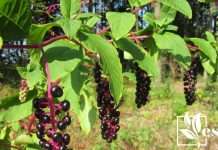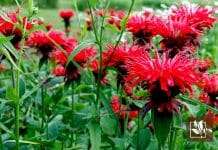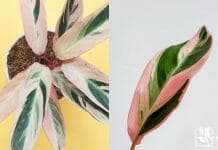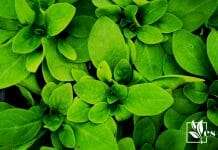Plants that look like chamomile will catch your attention once in a while, and you confuse them with the actual flower. Like the chamomile of the Chamaemelum genus, certain plants have a similar yellow dome and white ray petals.

In this post, we will list chamomile look-alikes and investigate if they can be used as alternatives. Read along so that, in the end, you can confidently spot the difference between these plants.
JUMP TO TOPIC
- List of Plants That Look Like Chamomile
- 1. Chamaemelum Nobile
- 2. Tripleurospermum Inodorum: Scentless Chamomile
- 3. Anthemis Cotula: Stinking Chamomile
- 4. Matricaria Discoidea: Pineapple Weed
- 5. Leucanthemum Vulgare
- 6. Achillea Ptarmica: Sneezeweed
- 7. Heliopsis Helianthoides: False Sunflower
- 8. Leucanthemum X Superbum ‘Brightside’
- 9. Anthemis Tinctoria: Dyer’s chamomile
List of Plants That Look Like Chamomile
These plants look similar to the German chamomile – Matricaria chamomilla. However, the plants differ in shape, structure, and usage. Check out these plants identical to chamomile.
1. Chamaemelum Nobile
While German chamomile grows annually, Chamaemelum Nobile is a perennial herb making it less common than the former. Chamaemelum Nobile is also called the English chamomile, Russian chamomile, or Roman chamomile. They are similar in various ways, and both can be processed into chamomile tea.
Both varieties grow naturally, and you can also plant them in the garden. The plants also give off a similar apple-like scent when you crush the foliage or blossoms.
Chamomile generally has a bipinnate leaf structure. While the German variety has thin, feathery leaves, the roman variety has thicker leaves with a different bipinnate structure. The stems of German chamomile are somewhat hairy, while the branches of English chamomile are hairless.
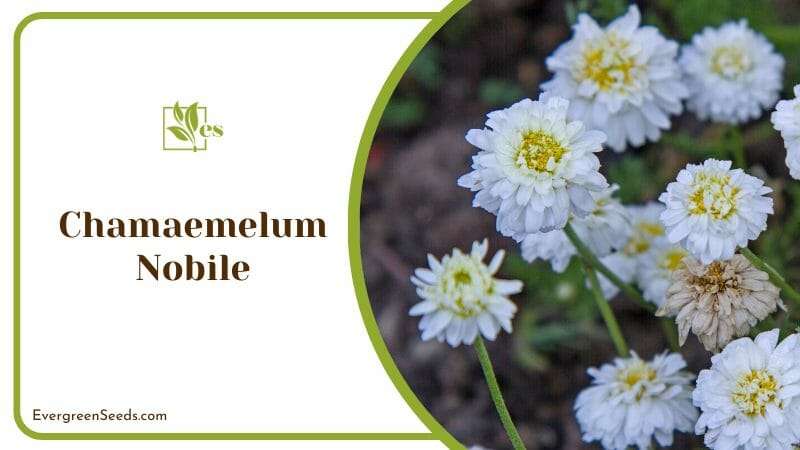
Also, the plants are different in length. The German groups of chamomiles grow longer, up to 2 feet, and thinner than their Roman counterparts. German groups are self-seeding and produce one bloom per stem.
The blossoms of these two plants also vary. To differentiate between both blossoms, pluck a flower with the stalk of either plant and look closely. German blossoms have tiny flowers with fully arranged petals, approximately 1 inch in diameter. While the English variety may look the same in size, they have larger centers with sparse petals.
Other English chamomiles do not produce flowers. Both chamomile plants have blossoms with a yellow center and white petals, representing the daisy star family.
2. Tripleurospermum Inodorum: Scentless Chamomile
Scentless chamomile has a similar flower type to chamomile. It is also known as false chamomile or Scentless Mayweed, with a second scientific name, Matricaria Perforata.
False chamomile belongs to the same family as chamomile, Asteraceae. Generally, plants of the same family tend to have similar features. Asteraceae is popularly called the star family due to its star-shaped flowers, and as a result, many plants from this family look like chamomile.
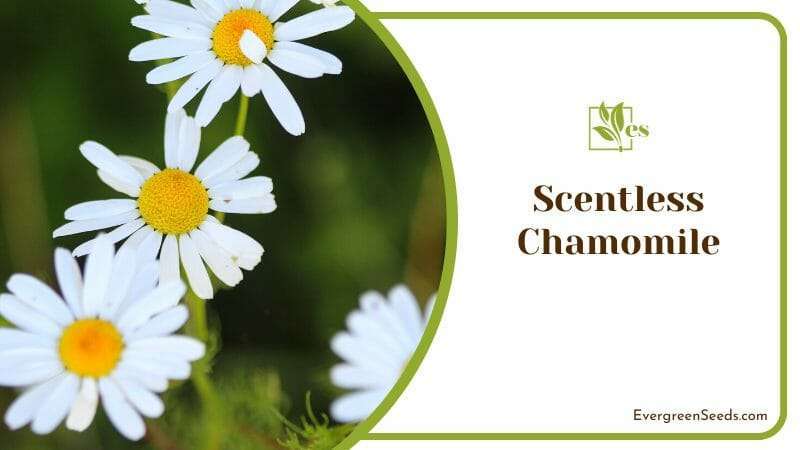
The scent is the easiest way to differentiate between German and false chamomile. Pluck small foliage of the flower, crush it in your hands and smell it. If you can perceive no scent, it is false chamomile.
Another difference when comparing mayweed vs chamomile is in the disc shape. False chamomile blossoms have a conical to semi-spherical center, while the German flower retains a hollow center.
Like chamomile, scentless chamomile is an annual plant that blooms from summer until the early fall months. It grows in cultivated fields, wasteland and road verge, forming dense masses of flowers during its season. The tree height ranges from 6 to 40 inches, similar to chamomile height.
3. Anthemis Cotula: Stinking Chamomile
The apparent difference between Stinking chamomile and chamomile again is the scent. Stinking chamomile is an annual plant also belonging to the family Asteraceae. The plant grows up to 2 feet in a highly branched and bushy appearance, similar to the German group.
You need not pluck and crush foliage before you perceive the scent. You will recognize the plant through its unpleasant smell if you move close enough. It is a weed, so you will find it on roadsides, fields, and meadows.
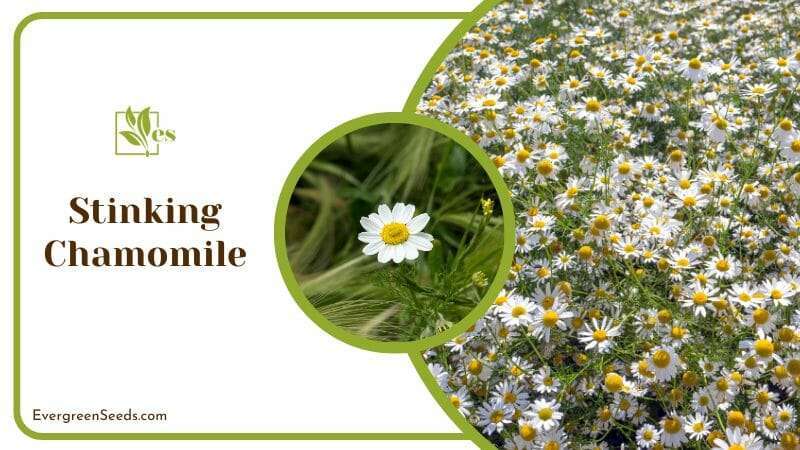
The plants have simple leaves arranged alternately. The leaves grow directly from the stem and are thick, finely, and deeply divided. Unlike the German variety, the leaves and stems have no hair, and old plants become dark red as they age.
The flowers are star-shaped without a flower stalk. They are held at the end of the branches. The disk flowers at the center are yellow with white petals. The white petals are usually in threes, with 10 to 15 ray flowers per blossom.
The overall look is like a cup, as the name ‘cotula’ implies. The plant is poisonous and irritates animal skin. Common names for stinking chamomile include dog fennel, dog Finkle, and chigger weed, among others.
4. Matricaria Discoidea: Pineapple Weed
While the German variety smells like an apple, Matricaria discoidea smells like pineapple. The plant grows shorter than the German group, up to about 11 inches.
The leaves are fern-like and thinner than the German variety. Another good indicator aside from the scent is the leaves. Are the leaves hairy or hairless? Pineapple weed has finely divided leaves without hairs.
The flowers look like chamomile from afar and are also known as wild chamomile. When you move closer, you will discover stunted and almost invisible petals. The flowers have a pineapple-like dome shape without white ray petals.
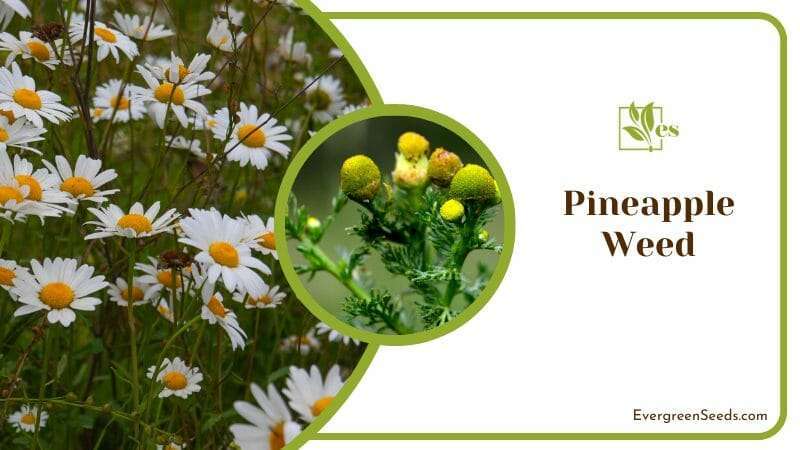
While chamomile has a yellow center, pineapple weed has a greenish-yellow center. As it is a weed, you will find the pineapple weed almost everywhere: from the wasteland to driveways, sidewalks, and soil locations.
Although it is an annual plant that grows as a weed, it is also edible. You can add raw leaves to salads and make refreshing drinks from the flower heads. You can also make syrup from the plant to incorporate a pineapple flavor into puddings, desserts, or ice cream.
Medicinally, Pineapple weed aids digestion and reduces stress like chamomile. It is also used to treat sores and fevers and to repel insects.
5. Leucanthemum Vulgare
Leucanthemum Vulgare is a perennial plant as opposed to the annual chamomile. It is also referred to as Chrysanthemum Leucanthemum, big daisy, ox-eye daisy, or dog daisy.
As a member of the Asteraceae family, you can almost confuse it with chamomile because of similarities in the flower type. While some flowers are small, some are up to 3 inches in diameter.
You can find big daisies mostly on fertile ground and in non-wetlands like fields, meadows, and forests. It can grow in unwanted areas when it begins to bloom between May and September. They have an unpleasant smell, like stale sweat.
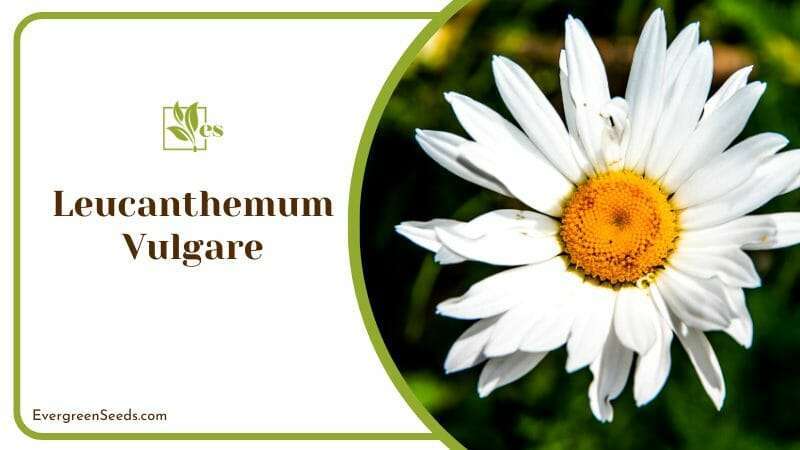
The stems occur singly, and some stems have full hairs, while some are sparsely hairy. Each stem has a flower and simple leaves arranged in an alternate form. The leaves occur in varying lengths. The long ones at the base and the shorter ones towards the top of the stem. They could be unlobed or lobed with toothed edges.
The flowers have a yellow disc center like the chamomile but have more petals, about 15 to 40 white petals surrounding the center. Then right below the flower dome, you will find glabrous, green bracts with brownish edges. They can be very toxic and are mainly used for ornamental purposes. However, the flowers can be processed into herbal teas.
6. Achillea Ptarmica: Sneezeweed
Achillea Ptarmica belongs to the same family as chamomile, asteraceae. It is also referred to as Sneeze-Wort, Fair-maid-of-France, Sneezeweed, or goose tongue. Achillea Ptarmica is a perennial plant that grows from June to October. It can grow in fertile and nutritionally poor soil. It grows best in moist soils, needing maximum sun exposure.
The plant grows up to 25 inches. The leaves are Linear-lanceolate. They give off an aromatic scent when you crush them. There are no leaf stalks, and the leaves are directly attached to the stem. Hairy, linear or Lanceolate and bright green are Sneezeweed leaf’s main features.
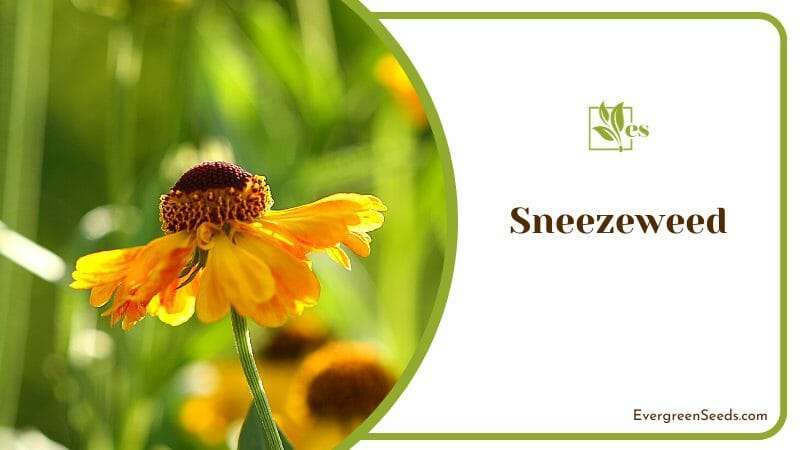
The flowers are similar to chamomile from afar but distinct after a closed look. Firstly, they are smaller, measuring less than 1 inch in diameter. The center has loose tubular florets with a dirty white pigment. A set of pure white barrel-shaped petals surrounds the center.
The leaves were usually dried and powdered from ancient times to induce sneezing, hence the common name Sneezeweed. It has a pungent smell. Asides from that, they use it as an insect repellent. You can plant it to array your garden or to create a perfect contrast for your borders.
7. Heliopsis Helianthoides: False Sunflower
False Sunflower has yellow petals, different from the white petals found in chamomile. It is also known as Smooth Sunflower or Smooth Oxeye. The plant is a perennial herb that grows up to 5 feet tall. The steam bears simple leaves, which have tooth edges.
The leaves are hairless, sandpaper-like, with green and rough hairy flower stalks. The flowers are carried in two layers of hairy bracts that appear to be a single row.
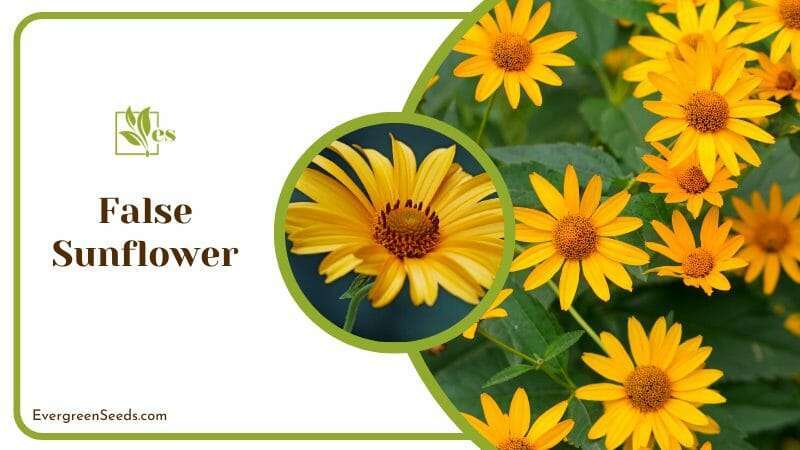
Aside from the difference in petal color, you can look below the flower for alternating long and short bracts. The leaves have rough and short hairs.
The plant grows and flourishes anywhere, from dry lands to fertile soil. The flowers are more prominent than chamomiles, measuring about 2 to 3 inches. It has yellow petals surrounding a yellowish-brown cone center. False Sunflower blooms from mid-June till the end of September.
8. Leucanthemum X Superbum ‘Brightside’
The Leucanthemum X superbum ‘Brightside’ has a flower type similar to chamomile. It is a member of the Shasta daisy group with the synonym Chrysanthemum superbum.
This group is commonly used as a beautification plant. Brightside daisy grows in an upright position, suitable for a garden. You can plant and tend it with other colored plants in your garden.
The flowers are larger than chamomile, with long white petals and a yellow center. Each stem bears dark green leaves, which are serrated and arranged in an alternate form.

The plant belongs to the Asteraceae family. It has a pleasant scent that makes it suitable for borders, entranceways, and cottage gardens. Like chamomile, Brightside flowers from July and stays bright and colorful throughout its season.
Shasta daisies go beyond the Brightside variety. Other varieties include
- Leucanthemum x superbum ‘Alaska.’
- Leucanthemum x superbum ‘Becky.’
- Leucanthemum x superbum ‘Aglaia’
- Leucanthemum x superbum ‘Banana Cream.’
- Leucanthemum x superbum ‘Daisy May.’
- Leucanthemum x superbum ‘Darling Daisy.’
- Leucanthemum x superbum ‘Esther Reed’
- Leucanthemum x superbum ‘Ice Star.’
- Leucanthemum x superbum ‘Snowcap.’
These plants belong to the Shasta daisy group, producing white daisy flowers in various sizes, colors, and shapes. Some have double petals, while others have feathery florets.
If you are familiar with chamomile, you will know how to identify chamomile differently from this group of daisies. They all bloom well in full sun and can survive under partial shade.
9. Anthemis Tinctoria: Dyer’s chamomile
Unlike chamomile, which has white petals, Dyers’ chamomile has yellow petals. It is perennial, although you can grow it as an annual plant. When you see the words Boston daisy or Paris daisy, you should know it is Dyer’s chamomile.
The leaves are serrated and dark green, producing a pleasant smell. Also known as Golden Marguerite, the plant grows to a bushy form, creating a bed of colorful flowers.
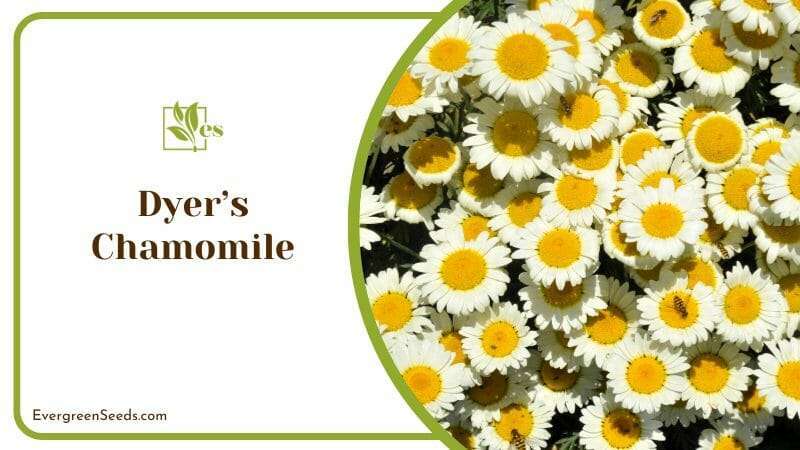 Green-Yellow Flowerbed of False Sunflower
Green-Yellow Flowerbed of False Sunflower
The stem bears stalks which the feathery leaves in an upright manner. A single stalk carries one blossom, so to achieve a good flower fence, you can plant several stalks.
The flowers are bright yellow throughout their season and are a good source of fabric dyes. You may ask, what kind of chamomile is used for tea? Almost all, but certainly not Anthemis Tinctoria. Dyer’s chamomile is most preferred for dying purposes.


